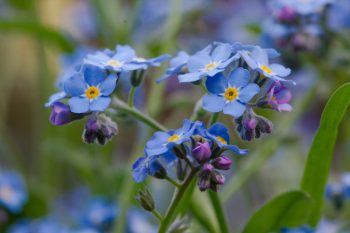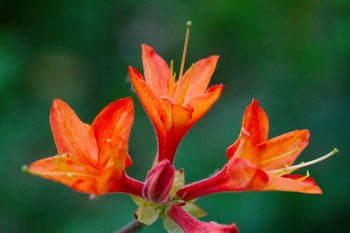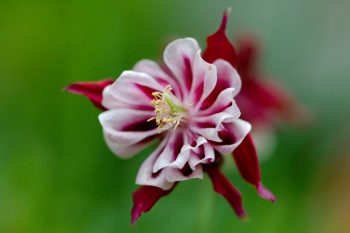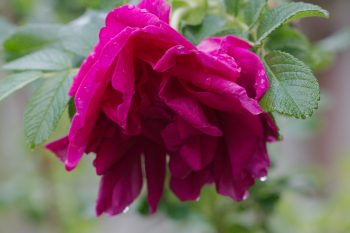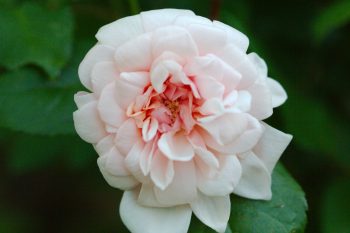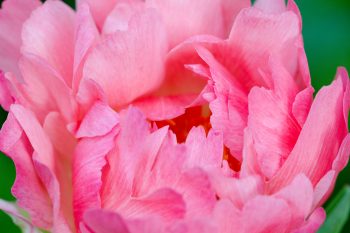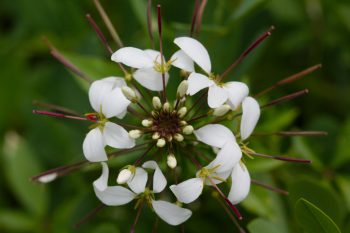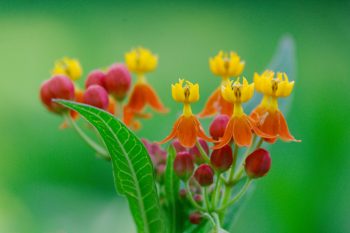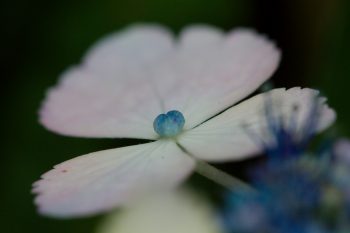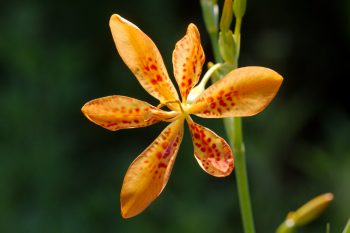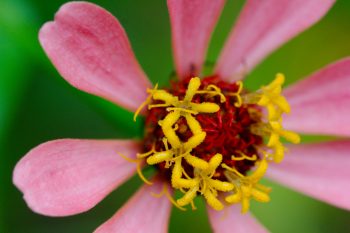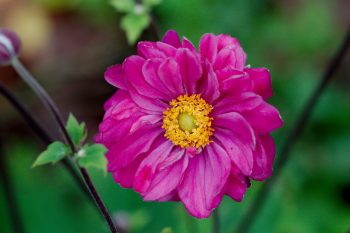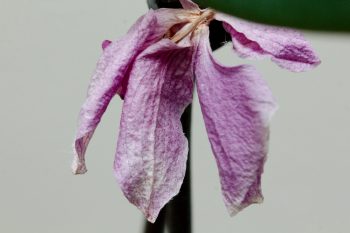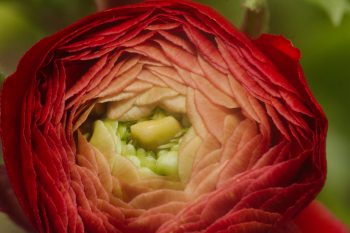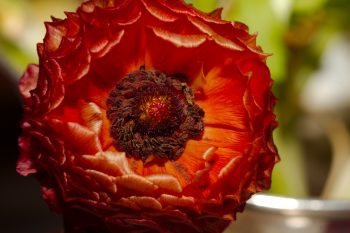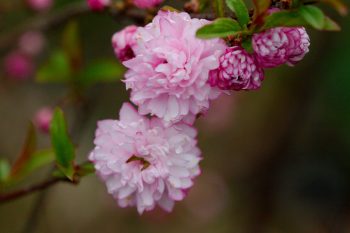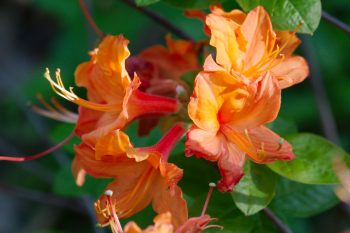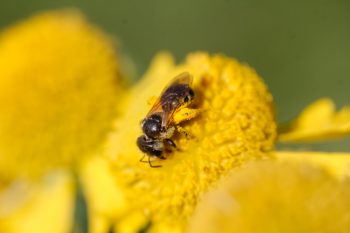The forget-me-nots (Myosotis sylvatica) are in full bloom in our garden. They self-seed and many of them are growing out in the grass. Cathy has dug a few up to replant in the garden beds where they won’t get mowed over. We both really love the powder blue of the forget-me-nots and are happy when the start to bloom. The buds are purple and the flowers, as they start to open, turn from a pinkish purple to the pure blue of the fully-formed flowers. You can see one transitioning at the right in this photo. The yellow “eye” in the center of each bloom turns white as the flower ages.
Tagged With: Bloom
Myosotis sylvatica (Woodland Forget-me-not)
Exbury Azalea
This Exbury azalea is starting to bloom. It’s been eaten back by the deer, so it’s not clear that it will ever get really big unless we are able to protect it. The flowers are quite striking, especially compared to the ubiquitous Glenn Dale azaleas that everyone has. I’ve got nothing against the Glenn Dales, mind you. But you have to admit, they have a certain sameness to them. I suppose if everyone grew Exbury or Mollis azaleas, I’d fell the same way. Or not. They really are spectacular and if you want yellows an oranges, they’re your best bet this time of year. They are deciduous, of course, so if you want leaves year round, they won’t do. But they sure make up for it in bloom.
Columbine
The columbine (Aquilegia canadensis) is really coming into bloom now in our garden. We have a few different varieties and I won’t swear that they are all this species (in fact I don’t think they are). But this one, I think probably is. It’s one of two that have flowers with a fuchsia or slightly purple color in their flowers. The other one is darker, almost tending towards a brownish red. It also has slightly more double white parts. They are both nice in their own way, and I’m pretty happy with this self seeding through out the garden. It doesn’t go out of control, like some self-seeders tend to do, so I don’t really mind.
Roseraie De l’Hay
My roses have had a rough few years. Three of them outright died in the last twelve months and I’m not entirely sure why. This one, a hybrid rugosa named ‘Roseraie De l’Hay’ lost a lot of stems but is still hanging on and has just started to bloom. The stems are relatively thin and the heavy flowers are too much for them, so they face pretty much downwards, especially after a rain. Like most rugosas, this rose has a really wonderful scent and the leaves are a beautiful green, generally untouched by any disease.
‘Perle d’Or’
In the continuing series of roses, this is one of my favorites. I’m down from a high of 13 roses in the garden to 5. One of those, Crépuscule, was nearly killed a few years ago after being by far the largest rose I had, covering a 20 foot trellis on the south end of the house. This on, a small china rose called Perle d’Or is growing just outside our front door. It lost a few canes to the cold this winter but is in full bloom now, really showing off and giving off a wonderful fragrance.
Peony ‘Coral Sunset’
This is one of three peonies that I planted in 2014, named ‘Coral Sunset’ that are growing will in the back garden. I’m a big fan of peonies and if I had a lot of space I might devote and entire garden room to them. There are both herbaceous and woody stemmed peonies and the are both worth growing. They do take a while to get established but they don’t really require much care. The reward in the huge, brightly colored flowers every spring. There is a nice peony garden at Seneca Creek State Park, if you are interested. I haven’t had a chance to go this year and it isn’t looking like I will, but it’s worth a peek, if you can get there when they are in bloom.
Cleome ‘Senorita Blanca’
On Sunday, as I mentioned, we went to Stadler Nursery in Laytonsville. Cathy bought a few things, including two Cleome plants, one white and one very pale pink. The white one, shown here, is called ‘Senorita Blanca’ and the other is ‘Senorita Mi Amor’. We’ve had Cleome ‘Senorita Rosalita’ in the past and these are (I assume) related plants with different coloration. My understanding is that they are sterile and will not self-seed, which is both good and bad. Annuals that do self-seed can become a real nuisance and get out of control. But some, if they only just manage to hold on, are really nice. Nigela is a good example of the latter. In our experience, it just self-seeds enough that we have it for a few years before needing to plant more. Other annuals, of course, go totally native and sterile plants are a real boon.
Asclepias curassavica Orange
This butterfly weed, Asclepias curassavica, is also known as blood flower. Cathy recently bought a few plants in both orange (this one) and all yellow. Sadly, it is not hardy enough for in-ground planting as a perennial here, but it should do well in containers and brighten up the back patio. This one is in a container right outside our kitchen door and looks great against the green backdrop of Rudbekia growing around the patio. I especially like the bi-color nature of this one, although the all-yellow variety is nice, too.
Hydrangea macrophylla
We have a pair of Hydrangea shrubs growing along the back of our garden. one of them is fairly large and growing strongly. The other, this Hydrangea macrophylla, is not so big but it’s blooming, at least. The deer seem to like it, so we’ve allowed the Forsythia to grow in front of it a little, to help protect it from them. Of course, that makes it harder for us to see, as well. You can’t have everything. The sterile florets, which have large petals, are a very pale pinkish with touches of blue. The much smaller fertile florets are quite blue, and the combination is quite nice.
Blackberry Lily (Iris domestica)
The blackberry lilies (Iris domestica and formerly Belamcanda chinensis) have started to bloom in the garden. We originally got this when I collected some seeds and planted them at our old house. We brought some here with us in 2006 and they have really taken hold. We sprinkle the seeds around and let them grow where they will. They aren’t nearly so aggressive as to be a problem and they are so pretty. I had a picture of the buds recently but this is the flower. They open in the morning and each individual flower only lasts a day, but they are born in profusion and soon we’ll have dozens of them in bloom, scattered around the yard.
Zinnia
This spring Cathy planted some zinia and marigold seeds. She’s talked about doing that for a few years but this year she actually got them planted. They grew under a plant light in our dining room in the late winter and into the early spring. They probably were started a little early because by the time it was safe to plant them outside they were a bit leggy and had already started to bloom. Still, I’d say they constituted a success. This one is growing in a pot on the back patio and it has pretty flowers. Not a lot of them, but every little bit counts.
Japanese Anemone
We’ve admired anemones in other peoples’ gardens for years and on occasion we’ve tried to grow them in ours but so far, nothing has taken. Cathy bought this one the other day from Stadler Nursery in Laytonsville and we’re going to give it another try. They really are lovely flowers and pretty plants in general. Hopefully we find the right spot for it where it can thrive and where we can enjoy it on a regular basis for years to come.
Dried Orchid Flower
This dried orchid flower, a Phalaenopsis, is on a plant in our kitchen. I’m a big fan of orchids but sadly haven’t been able to give those we have the attention that they rightly deserve. We’ve lost a few although a few others are getting by. In a perfect world, I’d water them more regularly and pay them more attention but we don’t live in a perfect world. Some things that I’d like to get to are passed over for more pressing matters. Maybe one day I’ll have the time to devote to them again. In the meantime, I’ll try to at least keep them alive. Inevitably I’ll fail for some of them. But then, they’re just plants and easily replaced.
Ranunculus asiaticus
While she was in Alaska from July to December, Dorothy got a job at a florist shop. She’s been exposed to flowers and plants to one degree or another all her life, having been dragged to various botanical gardens and arboreta. More recently she has come to appreciate them more than she did as a child. Nevertheless, her time at the florist has served to increase her love of flowers. This is a Ranunculus asiaticus, the Persian buttercup, and Dorothy brought home a bouquet of them for the dining room table. They are quite beautiful and I love the many overlapping petals of the deep crimson blooms.
Ranunculus
The Ranunculus that I photographed on January 17 continues to deliver. The flowers have opened up and are bright orangy-red with interesting centers. In another day or two they’ll be finished, I think, but we’ll get a little more enjoyment out of them. This time of year, flowers on the table are a nice extravagance. It’s actually getting a bit warm for this time of year and the forecast is for warmer still for a little while. I have no doubt that winter will return before long, though, and we’ll want to stay indoors.
Flowering Almond
This is the little flowering almond growing near the corner of our garage. It’s done pretty well the last few years, as we’ve had relatively mild winters but I don’t think it’s ever going to get more than about four feet tall. Maybe it isn’t in the best spot but it’s nice to have when it’s in bloom. There was a bumble bee on it and I tried to get pictures of that but this late in the day it’s in shadow and there just wasn’t enough light to get a sharp enough shot. The flowers are nice by themselves, though.
White Flowering Clematis
In the back of our garden, near the fence where there was a huge rose bush, there is a clematis. For years it’s struggled to be seen among the rose, which was often out of control. Well, the rose is gone now, having mysteriously died last year. I’m sad about that, and wish it hadn’t died but at least this beautiful, white clematis is still there and is doing quite well, now that it’s getting the sun it needs and isn’t overshadowed by the huge plant. We will need something for it to clime on but for now, it’s just happy to be blooming in the sun.
Backlit Iris
Cathy and I went for a walk in the neighborhood this evening and came across this iris, back lit by the setting sun. It was more purple in real life but I think the photo is pretty nice, anyway. I have a thing for back lighting, particularly of growing things. I love the luminescent quality and amazing colors of leaves and flower petals lit by the sun. I also took photos of our hawthorn, which is in bloom, and the first rose to open on ‘Perle d’Or’ outside our front door. But there will be more chances to photograph those in the days ahead.
Exbury Azalea
After work today I sat out in the yard. It was quite warm and I was enjoying the birds singing in the early evening. There is a family of house wrens (Troglodytes aedon) that have nested in a small, ceramic bird house hanging from our cherry tree and they make themselves known. I got a few photos of the wren but they’re small birds and I wasn’t really that close to it. I also surprised a rabbit (an eastern cottontail, Sylvilagus floridanus), who came around the corner and found himself much closer to me that he would have liked. He froze long enough for me to get a pretty good close up. But I decided to post this photo of the Exbury azalea that’s just finishing up a really nice blooming season.
Pollinator
This little bee is absolutely loaded with pollen. (Side question: if pollen is spelled with an ‘e’, why does pollinator have an ‘i’ in its place?) Anyway, Cathy and I went to Meadowside Nature Center this afternoon and walked around a pond and through the woods. In addition to this little bee, I got a pretty good photo of a common whitetail (Plathemis lydia), a fairly common dragonfly. But I thought I’d go with the bright yellow of this photo instead. I’m also partial to bees, of course.

